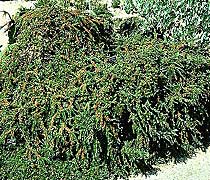


Home
Flowers &
Indoor Plants
Fruits & Nuts
Ornamentals
Vegetables
Special Topics
Resources
Glossary

|
Cotoneaster Cotoneaster sp. (co-tone-ee-ast-er) 

 Click on thumbnails for larger image. |
 |
What about it? There are several popular species in the Cotoneaster family: C. dammeri, the bearberry cotoneaster; C. horizontalis, the rockspray cotoneaster; and C. franchetti, the franchet cotoneaster. These species are similar in many ways. They are evergreen shrubs, deciduous in colder climes, with glossy green, finely textured foliage. In mid-June cotoneasters bloom with small pink flowers. The fruits are a red-orange color that will stay on throughout the fall season. ]n the late fall or early winter the foliage of the cotoneaster turns showy-red. Most grow in a horizontal direction, although some are more creeping or more upright than others. What is it used for? Cotoneasters can function as ornamentals, barriers, or erosion control. They can also be used in foundation planting or in a rock garden. Where does it grow? How do we grow it?Cotoneasters grow best in a well-drained, alkaline soil. They prefer partial sunlight. Plant them 4-6 feet apart. What are its primary problems? Cotoneasters can be subject to fireblight, borers, scale, and tent caterpillar. They can also suffer from twig kill due to cankers on occasion.
© Copyright, Department of Horticulture, Cornell University. |